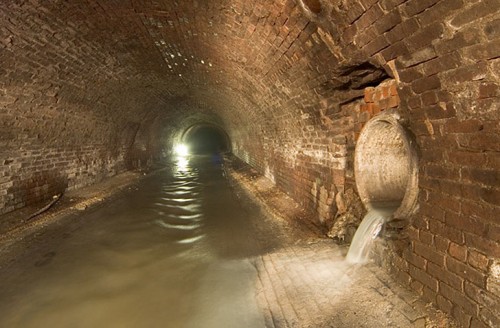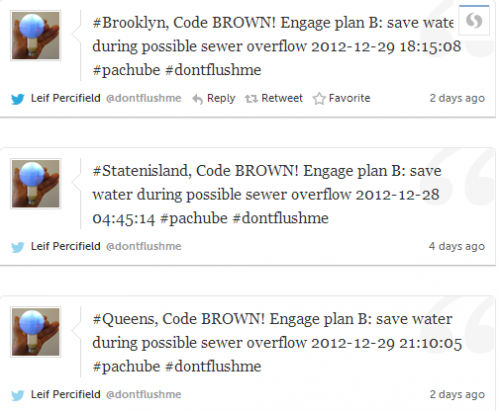
Science and Technology studies scholars have long understood that the physical structures and architectures of everyday life both reflect and construct human values, propensities, lines of action, and behavioral and social constraints. This was famously described by Langdon Winner with regards to the segregationist role of Robert Moses’ low bridges on the New York highway system. Recently on this blog, David Banks (@DA_Banks) wrote a beautiful essay on the technology, and technological artifacts of Troy New York. Indeed, the architectures of spaces in which we move shape how we move and reflect normative expectations about how we ought to move.
When thinking about urban landscapes, the role of these technologies, the processes by which they were constructed, and the place of each individual in the maintenance of them, is often obscured. For instance, in sprawled layouts, people get in cars to drive from their homes to dispersed strip malls and office complexes, reinforcing and/or spurring the need for interconnected road systems, parking lots, and an available personal vehicle. Or, in condensed urban areas, people ride bikes, walk, or hop on the bus, reinforcing and/or spurring the architectural need for public transit systems, bike lanes, and sidewalks. The way people move through space is both architecturally determined and agentically managed.
But if above ground structures, those which we physically tread on, are to remain implicitly in the background, invisibly visible, then what about that which dwells under the earth, on the margins, and out of site? What, more specifically, about waste? Humans produce waste. A lot of waste—much of which comes from our very bodies. Indeed, the average American produces 7 pounds of organic waste per day, largely made up of feces and urine. Cities have to somehow manage this waste, manage these now expelled parts of human bodies, manage that which we produce, drop, leave, and conscientiously ignore. Such management is typically engaged by an underclass of workers, the sanitation department, waste management employees, septic cleaners. When all goes well, waste remains invisible. Unsmelled. Unseen. Silently moved through underground systems and channeled out in ambiguous ways. This is a process to which most producers of bodily waste remain blissfully ignorant.
Sometimes, however, this waste management becomes a problem, and when it does, our expelled and forgotten matter spills back up into human view, reconnecting humans with the ways in which their own bodies must be managed through external structures; reminding humans of the dirty reality of organic embodiment. Such is the case in the New York City sewer system. High water levels, coupled with high waste levels, can lead to sewer overflows, flushing raw human waste into the city’s waterways—including the East River and the Hudson. Nothing reminds humans of their own embodiment like literal consumption of expelled matter. Nothing reconnects humans to an otherwise hidden process than their own shit floating down the river.
A recent solution to this problem of waste re-emergence comes from an unlikely place: social media. Leif Percifield recently introduced a social media tool called DontFlushMe, which allows New Yorkers to keep track of water levels and make waste management decisions accordingly—that is, decisions about whether or not to flush. The system works through sensors within the sewers, which notify users of high water levels via text message, Twitter, a call-in number or by a website. When water levels get too high, users will ostensibly “let it mellow,” reducing the influx of waste into the sewer systems, and preserving the waterways.
The role of social media here is particularly interesting. Here we have a social tool, a communication medium necessarily removed from the body and physicality, working to reconnect the user to hir body, and reconnect the body to the architectures and structures in which it dwells. This form of mediated communication thins the mediating line between personal actions and public good, between expelling and consuming, between individuals and infrastructures. This tool makes invisible processes visible, and turns everyone into stewards of the shared land.
Such reconnection—between humans and their bodies; between individuals and infrastructures—is facilitated by a tool so often accused of causing disembodiment and disconnection. Social media republicizes and disseminates responsibility for that which was previously relegated out of sight, smell, and mind. This “new” technology, ironically, brings us back to an earlier time of chamber pots and smelly streets, in which bodily awareness was a communal necessity.
Jenny Davis is a postdoctoral researcher in the social psychology lab at Texas A&M University. Follow Jenny on twitter @Jup83
*Special thanks to James Chouinard for bringing this social media tool to my attention, and for sharing his vast knowledge on the Sociology of Dirt.


Comments 4
Nilofar — January 1, 2013
Jenny, this has been a fascinating and informative read. I happened to read that paper Langdon Winner several months ago. It brought home explicitly the the abstraction that politics and policies can restrain and transform the way people engage with the built environment. However, I am not convinced that this social media tool DontFlushMe is connecting us to our corporeality. Rather, it further distances us from the physicality of what it really means to manage waste. Workers have to physically engage with our bodily fluids everyday, hidden from the visibility of the city's surface. An app mediated through screens, the Web and digital technology reinforces the abstraction of waste as physically 'unseen', as something that not only takes place underground, but in the background, away from the rhythms of daily life.
In India, for example, the practice of manual scavenging has been in existence for centuries. Although recent regulations have banned the practice and government is taking steps to rehabilitate the workers engaged in this traditionally "caste-based" profession, city dwellers were inured to the fact that it was people who managed their waste, and not processes or structures of the State. It was an abstraction for them - waste was being handled in the background, physically disconnected from their materiality.
What this tool does in effect is sanitize the process of sanitation, without allowing people to get their hands dirty.
jennydavis — January 1, 2013
Nilofar,
Excellent points. I certainly would not want to take my argument too far, or celebrate a full re-connection/unveiling of hidden waste management work. You are correct to point out that this is a mediated process. However, this mediated connection is a small step towards connection where before there was none at all. This takes us from flushed and forgotten to flushed and floating abstractly in our minds, on the margins perhaps, fleeting for certain, but present nonetheless.
Friday Roundup: January 4, 2013 » The Editors' Desk — January 4, 2013
[...] soc with his “‘Smart Parking’ and the Robert Moses Mistake,” Jenny Davis reconnected with waste, and David Banks reviewed Coding [...]
Reconnecting with Waste through Social Media » Sociological Images — January 25, 2013
[...] Reconnecting with Waste through Social Media by Jenny Davis PhD, seconds ago at 12:00 pm Cross-posted at Cyborgology. [...]